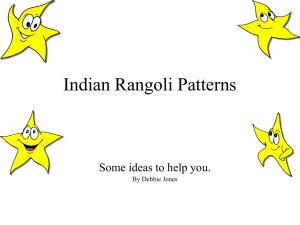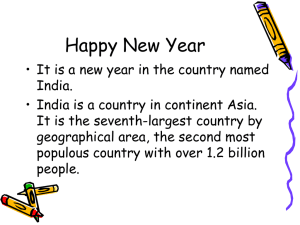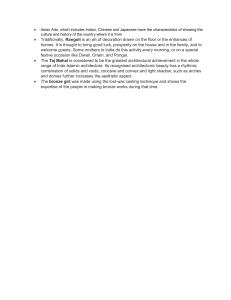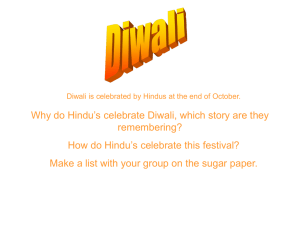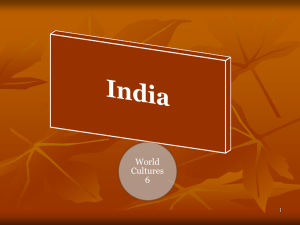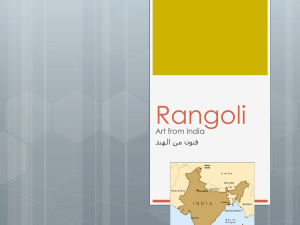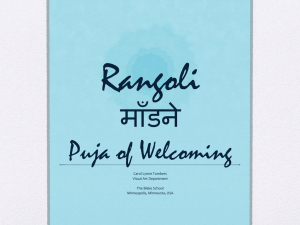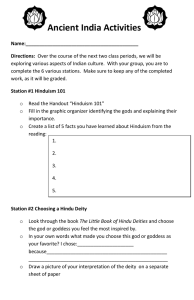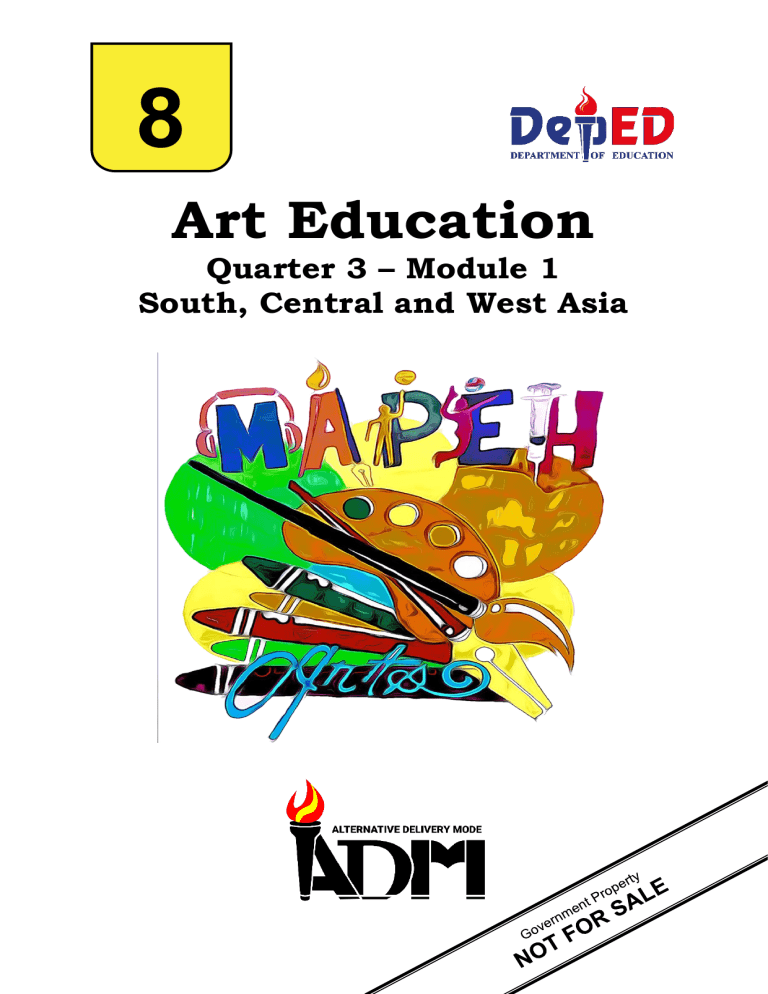
8 Art Education Quarter 3 – Module 1 South, Central and West Asia (cover page) Arts - Grade 8 Alternative Delivery Mode Quarter 3 – Module 1: South, Central West Asia First Edition, 2020 Republic Act 8293, section 176 states that: No copyright shall subsist in any work of the Government of the Philippines. However, prior approval of the government agency or office wherein the work is created shall be necessary for exploitation of such work for profit. Such agency or office may, among other things, impose as a condition the payment of royalty. Borrowed materials (i.e., songs, stories, poems, pictures, photos, brand names, trademarks, etc.) included in this book are owned by their respective copyright holders. Every effort has been exerted to locate and seek permission to use these materials from their respective copyright owners. The publisher and authors do not represent nor claim ownership over them. Published by the Department of Education – Division of Gingoog City Division Superintendent: Jesnar Dems S. Torres, PhD, CESO VI Development Team of the Module Author/s: Reviewers: Illustrator: Layout Artist: Joemar Padilla Valdevilla Mary Lailane C. Pelenio Sherwin A. Cuerdo, SEPS-SMN/OIC, EPS I – MAPEH Joemar P. Valdevilla Management Team Chairperson: Jesnar Dems S. Torres, PhD, CESO IV Schools Division Superintendent Co-Chairpersons: Conniebel C.Nistal ,PhD. Assistant Schools Division Superintendent Pablito B. Altubar CID - Chief Members: Sherwin A. Cuerdo, SEPS-SMN/OIC, EPS I – MAPEH Himaya B. Sinatao, LRMS Manager Jay Michael A. Calipusan, PDO II Printed in the Philippines by Department of Education – Division of Gingoog City Office Address: Telefax: E-mail Address: Brgy. 23,National Highway,Gingoog City 088 328 0108/ 088328 0118 gingoog.city@deped.gov.ph 8 Arts Quarter 3 – Module 1: South, Central and West Asia This page is intentionally blank Table of Contents What This Learning Package is About ........................................................................................ i What I Need to Know ..................................................................................................................... i How to Learn from this Learning Package................................................................................. ii Icons of this Learning Package ................................................................................................... iii What I Know.................................................................................................................................. iii Lesson 1: Periods of Indian Art ………………………………………………….………………………. 1 What I Need to Know .......................................................................................... 1 What’s New Activity 1: Indian Crepe ................................................................ 2 What Is It ............................................................................................................... 3 What’s More ....................................................................................................... 4 What I Have Learned Activity 2: Diwali Mobile ...................................................................... 5 What I Can Do ...................................................................................................... 6 Lesson 2: Rangoli ………………………………………………………………………….……………….. 7 What’s I need to know ......................................................................................... 7 What’s New......................................................................................................... ...8 What Is It ............................................................................................................ 9 What’s More ...................................................................................................... 10 What I Have Learned Activity 3: Rangoli Art …………………………………………….… 11 What I Can Do ................................................................................................... 12 Lesson 3: Creating East Asian Pakistan ………………………………………………………………….13 What’s I need to know …………………………………….................... 13 What’s New Activity 4: Truck Art ........................................................................... ...14 What Is It ............................................................................................................ 15 What’s More ...................................................................................................... 16 What I Have Learned Activity 5: Candle Sculpture …………………………………………17 What I Can Do ................................................................................................... 18 Summary ........................................................................................................................... …19 Assessment: (Post-Test) ................................................................................................. …21 Key to Answers ......................................................................................................................... …22 References …………………………………………………………………………………...… 23 What This Module is About In this module, you will learn about: ➢ How the visual art were produced and can be classified into specific periods, each reflecting particular religious, political and cultural developments ➢ How it intertwines with the enriching history, religions, and philosophies of the Subcontinent ➢ How strong sense of design can be observed in their modern as well as in their traditional forms ➢ How they exhibits ornate, very intricate and colorful motifs where a voluptuous feeling is given unusually free expression ➢ What are the five independent republics, that comprises Central Asia ➢ The Middle East is a region that encompasses Western Asia and all or part of North Africa i What I Need to Know At the end of this module, you as a learner are expected to: ➢ analyze elements and principles of art in the production of arts and crafts inspired by the cultures of South Asia, West Asia, and Central Asia (A8EL-IIIb-1 ) ➢ identifies characteristics of arts and crafts in specific countries in South, West, and Central Asia: India (rangoli, katak, mendhi, diwali); Saudi Arabia (carpet design); Pakistan (truck art); and Tibet (mandala), etc. (A8EL-IIIa-2 ) ➢ reflects on and derive the mood, idea or message from selected artifacts and art objects (A8PL-IIIh-1 ) ➢ appreciates the artifacts and art objects in terms of their utilization and their distinct use of art elements and principles (A8PL-IIIh-2 ) ➢ incorporates the design, form, and spirit of South, West, and Central Asian artifacts and objects to one’s creation (A8PL-IIIh-3 ) ➢ traces the external (foreign) and internal (indigenous) influences that are reflected in the design of an artwork and in the making of a craft (A8PL-IIIh-4 ) How to Learn from this Module To achieve the objectives cited above, you are to do the following: 1. Carefully read all the lessons. 2. Take your time on going thru each lesson. 3. Answer the pretest honestly; the purpose of the pretest is for you to determine your prior knowledge before going thru the lessons and activities. 4. If you have a hard time understanding the lessons and activities, please do take a break. Having breaks between lessons and activities will give you some space where you can absorb the lesson well. 5. You can use the internet if you need more information about the lesson. 6. Contact your subject teacher if you have some questions about the submission of your ii iii What I Know MULTIPLE CHOICE. Select only the letter of your choice and write you answer on the space before each number ___ 1. This is celebrated Hindus in India and all around the world in October or November. a. Diwali b. Rangoli c. Ajanta d. Taj Mahal ___ 2. This cave of Maharashtra , India are 30 rock – cut cave monuments that date back the 2 nd century. a. Diwali b. Rangoli c. Ajanta d. Taj Mahal ___ 3. The art of making designs or patterns on the walls or on the floor of the house. a. Diwali b. Rangoli c. Ajanta d. Taj Mahal ___ 4. The traditional form of rangoli made use of designs and motifs based on ____. a. Gods b. Rocks c. Nature d. Humans. ___ 5. Mohenjo Daro, Harappa, and Kot Diji are among the pre – Islamic settlement that are now tourist attraction I _____. a. Uzbekistan b. Pakistan c. India d. Tajikistan ___ 6. This kind of art in ancient Kazakhstan were part of daily routine. a. Visual art b. Fine arts c. Art of decorative carving d. Applied art ___ 7. The _____________ is very important for local residents in Tajiks. a. Visual art b. Fine arts c. Art of decorative carving d. Applied art ___ 8. They are known for making printed cloth. a. Uzbekistan b. Pakistan c. India d. Tajikistan ___ 9. This is mostly present I architectural monuments, household structures and objects in Tajiks. a. Carving b. .Architecture c. Painting d. Sculpture ___10. The most unique and beautiful carpets in the world are produced by______. a. Turkmenistan b. Pakistan c. Kyrgystan d. Tajikistan ___11. A homespun silk that is used for the beautiful dresses worn by Turkmen. a. Shirdaks b. Kotoni c. Keteni d. Shordiks ___12. Kyrgyz women produce a wide range of textiles, mostly from the felt of their a. Lamb b. Goat c. Cow d. Sheep ___13. This are large embroidered wall hangings traditionally made by Kyrgyzstan by elder women to commemorate the marriage of a son or daughter. a. Shirdaks b. Tush kyiz c. Keteni d..Shordiks ___14. West Asia is rich in ____ a. Memorial heritage b. Cultural heritage c. Commercial heritage d. Traditional art ___15. Handmade soap is produced from Syria and _____. a. Uzbekistan b. Turkmenistan c. Lebanon iv d. Tajikis Lesson 1 Title of the Lesson PERIODS OF INDIAN ART What I Need to Know Ancient Period (3900BCE-1200CE). There were evidences which show vigor and concern for surface texture as constantly characterized in Indian art of the early civilization like bronze and copper statuettes and steatite seals. http://en.wikipedia.org/wiki/Central_Asia The Ajanta Caves of Maharashtra, India are 30rock-cutcave monuments that date back from the 2nd century BCE to the 600 CE, including paintings and sculptures considered to be the masterpieces of Buddhist religious art, as well as frescos that are reminiscent of the Sigiriya paintings in Sri Lanka. 1 What’s New ACTIVITY 2: Indian Crepe You will need the following materials: • Dark-colored crepe paper/or any colored paper • Bleach (i.e., Chlorox) • Plastic cups • Cotton buds Procedure: 1. Draw your design on a piece of paper. 2. Spread out the crepe paper or the colored paper on a flat surface. 3. Pour a small amount of bleach in a plastic cup. Take care not to spill any on your clothes. 4. Slightly dip the tip of a cotton bud in the bleach. 5. Create designs on the crepe paper by gently drawing lines with the cotton buds. Be careful not to tear the thin crepe paper. 6. Decide on the pattern: repeated or alternative motifs, radial or border design. Rubrics Indicators 5 3 1 1. Considered the suggestions of each member to come up with a presentable work 2. Followed instructions correctly 3. Shared and applied the skills and talents on the activity 4. Manifested enjoyment while working with other group members Points Descriptive Equivalent Grade 16 – 20 Excellent 95% 11 – 15 Very Good 90% 6 – 10 Fair 85% 1–5 Needs Improvement 80% 2 What Is It http://en.wikipedia.org/wiki/Central_Asia Classical Period ( 5th to 6th centuries) The image of Shiva, the destroyer, develop into Shiva the Cosmic-dance the four arm figure, where one hand holds the fire with which he destroys, another holds a drum, which is the first sound heard in the world at birth, the third arm points up in a reassuring gesture and a fourth points down to the dwarf in which he dances. Islamic Ascendancy (1192-1757) or Transitional Period. This was the period of evolution from Vedism into Hinduism or Brahmanism. It is in this period that the Mahabharata and the Ramayana, the two great Indian epics emerged. http://www.google.com.ph/imgres?q=visual+art+from+india Mogul period( 16thCentury) The contribution of Moguls to the Indian culture is the enrichment of painting and architecture. Taj Majal is the most impressive example which was built in 1632 by Shah Jahan in memory of his wife. Another great Buddhist monument is the Borobudurin Java built in the 8th century after the decline of Buddhism in India. 3 What’s More http://www.britannica.com/EBchecked/topic/102315/history-of-Central-Asia Diwali is celebrated by Hindus in India and all around the world in October or November. It is the Hindu New Year and is either a 3-day or 5-day holiday depending on where you come from. It is a very exciting and colourful holiday, where homes are cleaned to welcome the New Year and windows are opened so that the Hindu goddess of wealth, Lakshmi, can enter. Hindus believed that she cannot enter a house which is not lit up, so every household burns special Diwali clay lamps (diyas) to light the way for the goddess, which is why the holiday is also known as the 'Festival of Lights'. 4 What I Have Learned ACTIVITY 2 DIWALI MOBILE Here is the procedure for the diya mobile. You will need: • Yellow textured paper or pages of magazines • Textured paper in bright color • Gold cord • Gold glitter • glue • String • Scissors • Puncher INSTRUCTIONS: 1. Cut out a flame shape from yellow paper and a diya shape from your other paper. 2. Make a hole at the bottom of the flame and another in the middle of the diya. 3. Tie them together with the gold cord. 4. Make a hole at the top of the flame and tie on some gold cord for hanging. 5. With glitter glue or a gold pen, write „Happy‟ on the flame and „Diwali‟ on the diya. http://en.wikipedia.org/wiki/Tibet 5 What I Can Do In this lesson, you will further understand how the lines, colors, shapes, balance, and repetition can give more meaning and significance to the art of Central Asia. This will help you: a. Understand the processes in art b. Determine its impact to you as an individual c. . Learn the importance of appreciating a work of art d. . Understand its relationship to other countries around you. 6 Title of the Lesson Lesson 2 RANGOLI What I Need to Know One of the most beautiful and most pleasing art forms of India is Rangoli. It is consist of of two words :”rang” meaning color; and “aavalli” meaning ' colored creepers' or 'row of colors'. Rangoli is the art of making designs or patterns on the walls or the floor of the house, uses finely ground white powder along with different colors. Numerous households in the Indian subcontinent make use of Rangoli designs for decorating the courtyard of their house. The traditional form of Rangoli made use of designs and motifs based on nature, such as mangoes, creepers, flowers, swans, peacocks, etc. Even the colors in the traditional art form were extracted from natural dyes, like barks of trees, leaves, indigo plant, etc. These days, synthetic dyes have more or less replaced the natural dyes of the earlier times. The materials used in the Rangoli patterns of today give either a very flat appearance or a 3-D effect. Rangoli designs include geometric patterns, the swastika, lotus, trident, fish, conch, creepers, leaves, trees, flowers, animals, etc. 7 What’s New 1. Describe the unique colors, forms, and shapes found in the Rangoli sample below. _____________________________________________________________ ____________________________________________. 2. Give your impressions on how Indians use the elements of arts these Rangoli samples. ______________________________________________________________ __________________________________________________. 3. What Pinoy artworks do we have that has similarity in these Rangoli? In what way they are similar? ______________________________________________________________ ____________________________________. 8 What Is It Rangoli is an art form, originating in the Indian subcontinent, in which patterns are created on the floor or the ground using materials such as colored rice, dry flour, colored sand or flower petals. q=map+of+central+asia&oq=map Rangoli, also known as kolam, is a folk art from India. Rangoli are decorative designs made on living room and courtyard floors during Hindu festivals typically consisting of bright colors. They are meant to be sacred welcoming areas for the Hindu deities. The ancient symbols have been passed down through the ages, from each generation to the next, keeping both the art form and the tradition alive. The patterns are typically created with materials including colored rice, dry flour, sand or even flower petals. Similar practices are followed in different Indian states: in Tamil Nadu, there is Kolam; Mandana in Rajasthan; Chowkpurna in Northern India; Alpana in West Bengal; Aripana in Bihar; chowk pujan in Uttar Pradesh; and others. The purpose of rangoli is decoration, and it is thought to bring good luck. Design depictions may also vary as they reflect traditions, folklore and practices that are unique to each area. Over the years modern additions have been adopted. It is traditionally done by women. Generally, this practice is showcased during occasions such as festivals, auspicious observances, celebrations of marriages and other similar milestones and gatherings. Rangoli designs can be simple geometric shapes, deity impressions, or flower and petal shapes, but they can also become very elaborate designs crafted by numerous people. The base material is usually dry or wet granulated rice or dry flour, to which sindoor, haldi and other natural colors can be added. Chemical colors are a modern variation. Other materials include colored sand and even flowers and petals, as in the case of flower rangolis.0 9 What’s More Did You Know? Vibrancy and color have always been how Indian outlook is perceived. India is recognized globally for its distinct flavor and Rangoli is one of them. As part of Indian Culture, Rangoli is used to beautify homes, places of worship and any place that calls for celebration. Combining symmetry, precision, and complexity, Rangoli is designs made of geometrical lines drawn on the floor, composed of curved loops. Marking are designed around a grid pattern of dots. The medium used to outline patterns is often rice powder, chalk, white rock powder and chalk powder. Natural and synthetically colored powders are used to fill up the shapes and enhance the contours of the drawing. A common sighting in Southern India, Rangoli is referred by different names according to region and language. Hase in Karnataka, Muggulu in Andrapradesh, the Rangoli is an ancient art passed down the generations as an essential part for any ritual or festival. http://en.wikipedia.org/wiki/Bodhisattva 10 What I Have Learned ACTIVITY 3: Rangoli Art You will need: • Glue • Plain paper plate • Pencil • Colored sand (different colors) DIRECTION : http://en.wikipedia.org/wiki/India#History 1. Sketch your design lightly in pencil or chalk. 2. When you are happy with your design, finalize the outline with heavier lines. 3. Use glue to outline your design. 4. Roll the paper plate into a cone and snip a small hole in the narrow end. 5. Fill the larger opening with colored sand. Use your finger as a stopper on the small hole you made. This is how you will control the flowof the sand 6. Fill in your design with sand according to your choice and color combination. This is the most interesting step, and usually the most fun. 7. Apply different design patterns: 8 .Display your work in class 11 What I Can Do Fill up the following circles according to how you feel after using this module. Make a caricature of faces using dots and lines. Direction: 1. Inside the circle draw a face using dots and lines base on the emotion above. Example: Happy Surprised Amazed 12 Sad Lesson 3 Title of the Lesson PAKISTAN What I Need to Know http://t0.gstatic.com/images?q=tbn:ANd9GcSPKTmb84gkTedUb- Pakistani architecture is divided into four recognized periods: Pre-Islamic Islamic, Colonial and Post-Colonial Mohenjo Daro Around the middle of the 3rd millennium BCE,an advanced urban culture developed for the first time in the region, with large buildings, some of which still survive to this day like Mohenjo Daro, Harappa and Kot Diji which are among the pre-Islamic settlements that are now tourist attractions .Kot Diji Across Pakistan, brightly colored flamboyant trucks painted with images of idealized landscapes, famous personalities, flowers and trees turned village lanes, city streets and long-distance highways into a national gallery without walls, a free-form, kaleidoscopic exhibition in perpetual motion. 13 What’s New ACTIVITY 3: VIDEO PRESENTATION –TRUCK ART http://www.youtube.com/watch?v=YquXjaSz2dQ Uploaded by journeymanpictureshttp://www.youtube.com/watch?v=4EhNAib0b6Q Guide Questions 1. Describe the unique lines, color, forms and shapes found in Pakistan‟s truck art._______________________________________________________________________ _________________________________________________________________________ _________________________________________________________ 2. Give your impressions on how Pakistan use the elements of arts in their artwork. _________________________________________________________________________ _________________________________________________________________________ _______________________________________________________ 3. Compare our Pinoy jeep with their truck art with regards to the color, design, forms and shapes.___________________________________________________________________ _________________________________________________________________________ _____________________________________________________________ 14 What Is It http://www.youtube.com/watch?v=YquXjaSz2dQ Pakistan Truck Art This site is dedicated to the celebration and promotion of Pakistani truck art. Anyone who has been to Pakistan knows that the sight of a fully decorated truck is unforgettable. A truck embellished from bumper to bumper with paint and colorful, sculpted metal is expressive and captivating in ways that few other artistic media can duplicate. Decorated Pakistani trucks declare a dazzling, exuberant artistry that is unmatched on vehicles anywhere else in the world. Pakistani truck art takes two forms— murals or painted scenes and “decoration pieces.” This website features one truck art enthusiast’s collection of decoration pieces and a blog that includes everything and anything related to Pakistani truck art. Decoration pieces typically adorn a truck’s side carriage and are placed on top of a mural or painting. Ranging in size from less than a square foot to more than six feet, decoration pieces are often the flashiest part of a fully embellished truck. Consisting of a metal base covered with colorful reflective stickers, or chamak patty, and further highlighted with mirrors or studs, decoration pieces are shaped to represent any of the truck art motifs, such as birds, fish, and flowers. The decoration piece is an important flourish on the truck because the artistic materials make the piece the most reflective part of the vehicle. There is no Urdu word for decoration piece, and both truck drivers and truck artists will use the English term. The collection on this site includes decoration pieces that were actually used on trucks as well as other works that were acquired before they were taken on the road. A few pieces were custom made, extending the aesthetic used in traditional decoration pieces to new, innovative forms. Although all of the pieces are unique, replicas are available by contacting Ehtisham/Ethan 15 What’s More Did you know that candles have been used as a source of light since 4 BC? Picture 1800’s Europe: as the practice of mold making was expanding to allow for a variety of shapes and sizes, many methods in candle making were simultaneously being developed. One traditional method that carried forward to present day was first seen in Germany and Holland: the process of dipping layers and carving ornate designs into hot wax. This method created the earliest carved candles, known today as “Cut and Curl” Candles. The traditional technique of candle carving would involve colorful and ribbon-like layers cut into strips, and adhered back onto the candle. Certain tricks with engraving, folding, and scoring add elegant touches to a finely embellished candle. http://en.wikipedia.org/wiki/Central_Asia http://en.wikipedia.org/wiki/Central_Asia 16 What I Have Learned ACTIVITY 4: CANDLE SCULPTURE MATERIALS NEEDED: • Old news paper • Pencil • Candle –2” in diameter • Sketch of your chosen design • Nail pusher • Black permanent marker http://www.orexca.com/centralasia.php DIRECTIONS: 1. Spread out the old newspaper to protect your work area. 2. Sketch your chosen design on the candle using your pencil. Use geometric shapes and patterns like scroll lwork and curved lines. 3. With the nail pusher, carve the design on the candle. Use the subtractive technique to cut away the unwanted part 4. Highlight the design with the use of a black permanent marker RUBRICS Indicators 1. Directions and procedures were followed accurately 5 3 1 2. Art elements and design were used and are clearly evident 3. Artwork shows creativity and effort Numerical Descriptive 11 –15 Excellent 6 -10 1 -5 Grade Equivalent 95% Good 85% Need Improvement 17 75% What I Can Do DRESS ME UP!!! Dress me up according to the country I came from in Central Asia. Describe the designs, forms, colors and style to signify the country I came from. Direction: 1. Cut pictures from used magazine choosing the kind of dress that best describe Central Asia. 2. Paste the cut out dress on the lady. 3. Dress up the lady according on your own design. Following Direction Creativity and Workmanship Resourcefulness Numerical 11-15 8-10 6 Excellent-5 Good -4 Fair-3 Followed the direction correctly Output is very creative and tidy Materials used were all recycled Followed most of the direction Output is good and tidy Followed some of the directions Output if fair Most of the materials used were recycled Some of the Materials used materials used were not were recycled recycled Descriptive Excellent Good Need Improvement 18 Equivalent Grade 95% 85% 75% Needs Improvement-2 Did not follow the instruction Output is dull Summary Carving - the act of fashioning or producing by cutting into or shaping solid material, as wood. Conch - is a common name that is applied to a number of different medium to large-sized sea snails or their shells. The term generally applies to large sea snails that have a high spire and a siphonal canal deity - is a being, natural, super natural or preternatural, with superhuman powers or qualities, and who may be thought of as holy, divine, or sacred. Distinctive - having a special quality, style, attractiveness, etc; notable Diwali - celebrated by Hindus in India and all around the world in October or November. It is the Hindu New Year and is either a 3-day or 5-day holiday depending on where you come from. Diyas - special Diwali clay lamps Ecological - the branch of sociology concerned with the spacing and interdependence of people and institutions. Emulating - to strive to equal or excel, especially through imitation Emulous -Eager or ambitious to equal or surpass another. Encompass - to enclose; envelop; to constitute or include Flamboyant - marked by or given to strikingly elaborate or colorful display or behavior Frescos - a technique of mural painting executed upon laid lime. Water is used as the vehicle for the pigment and, with the setting of the plaster, the painting becomes an integral part of the wall. Inscriptions - something inscribe; a historical, religious, or other record cut, impressed, painted or written on stone, brick, metal or other hard surface Kaleidoscope- is a cylinder with mirrors containing loose, colored objects such as beads or pebbles and bits of glass. As the viewer looks into one end, light entering the other creates a colorful pattern, due to the reflection off of the mirrors. 30 Keteni - a homespun silk that is used for the beautiful dresses worn by Turkmen women on special occasions. Lakshmi - the Hindu goddess of wealth Loom - a hand-operated or power-driven apparatus for weaving fabrics, containing harnesses, lay, reed, shuttles, treadles, etc. Nomads -a group of people that moves from one place to another Ochre - is the term for both a golden-yellow or light yellow brown color and for a form of earth pigment which produces the color. Ornament - an accessory, article or detail used to beautify the appearance of something to which it is a part. 19 Ornate - elaborately or sumptuously adorned, often excessively or showily so. Petroglyph - (also called rock engravings) are pictogram and logo gram images created by removing part of a rock surface by incising, picking, carving, and abrading. pictogram - a picture or symbol for a word or group of words Rangoli - the art of making designs or patterns on the walls or the floor of the house, uses finely ground white powder along with different colors. Repeated -a duplicate or reproduction of something; a decorative pattern repeated, usually by printing, on a textile or the like. Shawls - a simple item of clothing, loosely worn over the shoulders, upper body and arms, and sometimes also over the head. It is usually a rectangular or square piece of cloth, which is often folded to make a triangle. Sometimes it can also be triangular in shape. Other shapes include oblong shawls. Shirdaks - hand-made carpets or rugs; flat cushions made in shadow-pairs Shiva -is a major Hindu deity, and is the Destroyer or Transformer among the Trimurti, the Hindu Trinity of the primary aspects of the divine. siphonal canal - is an anatomical feature of the shells of certain groups of sea snails 31 swastika - an equilateral cross with four arms bent at 90 degrees. The word swastika came from the Sanskrit word svastika, meaning any lucky or auspicious object, and in particular a mark made on persons and things to denote auspiciousness. Tajiks - an ethnic group Tajikistan, Afghanistan, Uzbekistan, Iran, Russia and China Trident a three-pronged spear; the traditional weapon of the Hindu god Shiva used as a geometric design for Rangoli Utilitarian - having regard t utility or usefulness rather that beauty, ornamentation, etc. Vegetative - noting the parts of a plant not specialized for reproduction Voluptuous - focused attention on the female body as a source of aesthetic pleasure, sexual attraction, fertility, and reproduction, considered an ideal or preferred body shape, both for attractiveness and for health reasons. Yurt - is a portable, bent wood-framed dwelling structure traditionally used by nomads in the steppes of Central Asia Assessment: (Post-Test) 20 A. INDIA Identification: Choose the correct word from the box below Diwali Rangoli Shiva Lakshmi Diyas 1. The art of making designs or patterns on the walls or floors of houses.______________ 2. Hindu Goddess of wealth.______________ 3. A four arm dancing Hindu Goddess.______________ 4. The festival of light of India.______________ 5. Clay lamp to light the way of the Goddess. B. CENTRAL ASIA AND MIDDLE EAST Multiple Choice: Read the directions correctly. Choose the best answer. Write the letters only ______1. Country known for making printed table cloth, curtains, bed spreads and shawls a. Uzbekistanc. b. Tajikistan c. Kazakhstan d. Pakistan ______2. Country in Central Asia known for utensil making, musical instruments, furniture and jewelries a. Pakistan b. Uzbekistan c.Tajikistan d. Kazakhstan ______3. A homespun silk used for beautiful dresses worn by Turkmen women a. Shirdaks b. ketene c. Tush Kyiz d. Diyas ______4. It is a large elaborately embroidered wall hanging made in Kyrgystan and Kazakhstan a. ketene b. shirdaks c. frescoes d. tush Kyiz ______5. Images created by removing part of the rock surface by incising, picking and Carving a. petroglyphs b. calligraphy c. hieroglyphs d. ochre Identify the arts of the following countries. Choose from the letters below and write only the letter of your choice. ___ 1. Turkmenistan ___ 2. Pakistan ___ 3. India A. Keteni Cloth C. Truck Art Key to Answers ____ 4. Uzbekistan ____5. Tajikistan B. Rangoli D. Diwali Lamp 21 Pre test 1. A 2. D 3. B 4. D 5. D 6. D 7. C 8. B 9. C 10. C 11. A 12. A 13. B 14. C 15. D Post Test *** Can you read the Caricature -STAN -DIWALI -YURTS -RANGOLI -TAJIKS *** Test Yourself A B 1. Rangoli 2. Lakshmi 3. Shiva 4. Diwali 5. Diyas 1. A 2.b 3.c 4.d 5.a ***Identification 1. 2. 3. 4. A C D A References 22 Africa, Antonio P. et. al, Practical MAPEH 8 Textbook; (Philippine Copyright 2018) Diwa Learning System Inc.ISBN: 978-971-46-1244-0 RS-RRB-RRS Anido, B. et.al. Music and Arts Grade 8 Learners Module, (First Edition, 2013) ISBN 987-971-9601-73-9 http://images.redstate.com/files/map9-middle-east-and-cent.gif http://en.wikipedia.org/wiki/India http://en.wikipedia.org/wiki/Central_Asia http://www.google.com.ph/imgres?q=visual+art+from+india http://www.britannica.com/EBchecked/topic/102315/history-of-Central-Asia http://en.wikipedia.org/wiki/Tibet http://en.wikipedia.org/wiki/India#History http://www.google.com.ph/search?num=10&hl=en&site=imghp&tbm=isch&source=hp&biw=1 137&bih=538&q=india+map http://www.google.com.ph/search?hl=en&biw=1137&bih=491&site=imghp&tbm=isch&sa=1& q=map+of+central+asia&oq=map http://www.hobbycraft.co.uk/Pages/Ideas/Idea.aspx?id=1352 http://t0.gstatic.com/images?q=tbn:ANd9GcSPKTmb84gkTedUb80DnxKJ4rz8DsBMDrkWvWwkWfegG7I6tjijA http://en.wikipedia.org/wiki/Bodhisattva http://www.amazingtibettravel.com/about-tibet/tibetan-art.htm http://www.google.com.ph/search?um=1&hl=en&biw=1137&bih=491&tbm=isch&sa=1&q=tra ditional+food+of+tibet&oq=food+of+tibet&gs_ http://www.travel2abroad.com/Link-Info/250/23/10/Indian-Subcontinent/Tibet/Food http://www.youtube.com/watch?v=YquXjaSz2dQ http://www.google.com.ph/search?hl=en&biw=1137&bih=538&site=imghp&tbm=isch&sa=1& q=thangka+painting+of+tibet&oq=thangka+painting+of+tibet http://www.flickr.com/photos/pedrosz/341500212/ http://www.google.com.ph/search?hl=en&biw=1137&bih=491&site=imghp&tbm=isch&sa=1& q=deerstones+of+tibet&oq 33 http://www.google.com.ph/search?hl=en&biw=1137&bih=491&site=imghp&tbm=isch&sa=1& q=gengkis+khan+of+tibet http://en.wikipedia.org/wiki/Ajanta_Caves http://en.wikipedia.org/wiki/Central_Asia http://www.thepaltrysapien.com/2012/07/pakistani-truck-art-and-the-art-is-essential-to-life23 discussion/ http://www.google.com.ph/search?um=1&hl=en&biw=1137&bih=491&tbm=isch&sa=1&q=fol k+arts+of+kazakhstan&oq=folk+arts http://www.advantour.com/uzbekistan/culture/handicrafts/dolls.Htm http://en.wikipedia.org/wiki/File:Mohatta_Palace.jpg http://www.central-asia.info/kazakhstan/culture http://www.google.com.ph/search?um=1&hl=en&biw=1137&bih=491&tbm=isch&sa=1&q=tur kmenistan+SILK&oq=turkmenistan+SILK http://www.ehow.com/list_6703312_india-art-activities.html http://www.culturalindia.net/indian-history/index.html http://www.culturalindia.net/indian-art/rangoli/index.html http://www.kiddiegardens.com/painting_clay_pots.html http://t0.gstatic.com/images http://www.orexca.com/centralasia.php http://www.advantour.com/central-asia http://www.youtube.com/watch?v=4EhNAib0b6Q http://en.wikipedia.org/wiki/Middle_East http://www.google.com.ph http://t2.gstatic.com/images http://www.fancy4glass.ca/inventory-images http://img.artknowledgenews.com/files2011dec/Anselm-Kiefer-West-Eastern-Divan.jpg 34 http://www.activityvillage.co.uk/ http://t1.gstatic.com/images?q=tbn:ANd9GcQZXxh8ApgWYrYGu_v8ZKI6XhgFYdksjBbnVwrl dWxwrT7f8E1GXA http://www.middleeastcouncilnc.org/home/MECC-artscrafts.php http://t0.gstatic.com/images?q=tbn:ANd9GcTpNx7dDYIfApNZ_KHx6VbJWopj_xCzdMXqapGup0xH9b6rhVe http://t1.gstatic.com/images?q=tbn:ANd9GcSD0d7exUCrNbO_CJsPsl73qL83RqMUwmzrKQ YX3XeZvF6-IfNcSA http://t0.gstatic.com/images?q=tbn:ANd9GcTpNx7dDYIfApNZ_KHx6VbJWopj_xCzdMXqapGup0xH9b6rhVe http://t0.gstatic.com/images?q=tbn:ANd9GcSTJiqX4iVVdmz0kkULc7UjQVw_pZm8prcTGuy qxrpGl7LO1DHJ http://www.google.com.ph/imgres?q=soap+carving+patterns&num=10&hl=fil&newwindow=1 &biw=1137&bih=538&tbm=isch&tbnid=EImg-J0OPvQSiM:&imgrefurl= http://www.glogster.com/cutiepie225/soap-carving/ 24 http://www.google.com.ph/imgres?q=soap+carving+patterns&num=10&hl=fil&newwindow=1 &biw=1137&bih=538&tbm=isch&tbnid=WtH0qu68EshTDM:&imgrefurl= http://te448spring09.blogspot.com/2009/03/soaphttp://dictionary.reference.com/browse/ 25 For inquiries and feedback, please write or call: Department of Education – Bureau of Learning Resources (DepEd-BLR) Department of Education – Division of Gingoog City Office Address: Brgy. 23, National Highway,Gingoog City Telefax: 088 328 0108/ 088328 0118 E-mail Address: gingoog.city@deped.gov.ph

